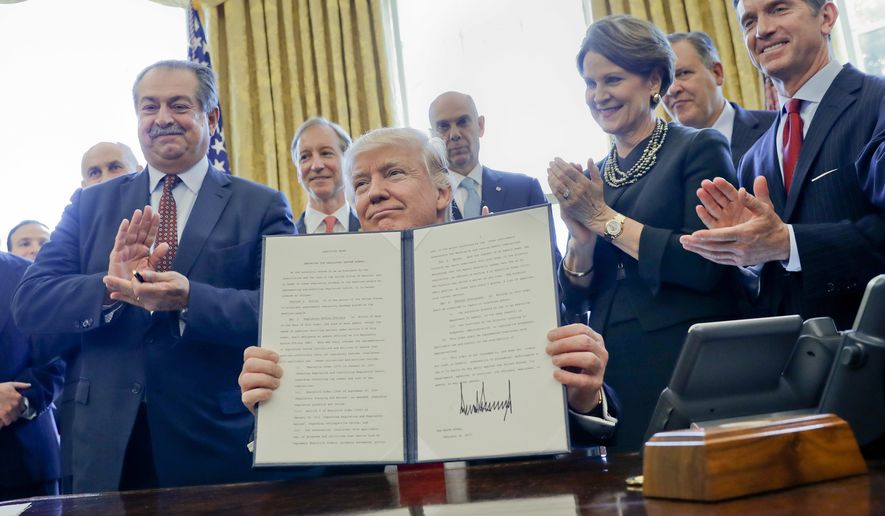The Trump administration ripped up federal regulations at a record pace this year and saved taxpayers $1.3 billion, double the goal set by the president, according to an American Action Forum analysis.
Casey Mulligan, chief economist of the President Trump’s Council of Economic Advisers, said the budget savings are actually higher because the Obama administration underestimated the cost of its red tape. Government budget scorekeepers use the estimated budget cost at implementation to assess savings from a rollback. The same data were used in the analysis.
“President Trump is not getting rid of all regulations by any means. But some of the most problematic ones, he’s getting rid of them,” Mr. Mulligan said.
Mr. Trump credits deregulation as much if not more than tax cuts with fueling the economic surge.
One of his first moves as president issuing Executive Order 13771 that directed agencies to repeal two regulations for every rule enacted. The new mindset resulted in a larger rollback. By the end of calendar year 2017, agencies nixed 22 regulations for every new rule, according to the White House.
The White House estimated the lifetime savings from those actions at $8.1 billion.
Despite the budget savings, most economists agreed that the effort barely dented the estimated $1.9 trillion it costs Americans to comply with federal regulations each year.
The White House economic team is working on measuring the reduction in compliance costs, Mr. Mulligan said.
The administration forecast $686 billion in savings from deregulation this fiscal year, which ends Sept. 30. The rollback has netted $1.3 billion in savings, according to data compiled by American Action Forum, a center-right think tank in Washington.
The savings resulted from 47 major deregulator actions that the administration identified through July. The number does not include all rules issued by agencies, which total in the thousands.
The savings also are spread unevenly across agencies.
The Labor Department saved the most: $417 million, more than three times the $137 million savings in the 2018 budget.
The Department of Energy was budgeted for a $80 million reduction but so far has achieved zero. No actions were taken that qualified under Mr. Trump’s executive order for deregulation.
The Pentagon was slated to nix $70.9 million but saved just $2.6 million with a total of three major actions.
“It will be worth watching to see if these agencies ramp up their deregulatory activity to maximize their savings ahead of September 30,” wrote Dan Bosch, American Action Forum’s director of regulatory policy.
Clyde Wayne Crews, vice president for policy at the libertarian Competitive Enterprise Institute, said the added economic boost resulted from the change of the government culture under Mr. Trump more than from any set of eliminated regulations.
“I don’t put it to compliance costs, but in terms of slowing the growth of new regulations, that’s been a major change,” he said.
In 2017, the Federal Register that lists new rules, proposed rules and notices contained 61,308 pages — the lowest count since 1993, according to Mr. Crews’ annual report on federal regulations “Ten Thousand Commandments.” The 2017 page count also marked a 36 percent drop from President Obama’s 95,894 pages in 2016, the highest level on record, according to the report.
Mr. Trump’s assault on regulations is not without detractors.
Jared Bernstein, an economist at the Center on Budget and Policy Priorities, said deregulation doesn’t significantly add to economic growth and comes at a human cost.
“There could be deregulations that mess with people’s lives in undesirable ways and show up in GDP at the margins,” said Mr. Bernstein, who served as chief economist to Vice President Joseph R. Biden. “If you count the negative impact on people’s well-being, I suspect the modest [economic] effect goes to zero.”
He pointed to Mr. Trump’s repeal of Mr. Obama’s Fair Pay and Safe Workplaces order that, in part, required companies bidding on federal contracts to disclose purported labor violations.
“It is possible that the government could save money without that regulation because they end up writing contracts with firms that pay less than firms that abide by labor laws. So that, to me, is a very concrete example in which you could see government savings. If it was big enough, it could end up in GDP growth, but the workers on those contracts are illegally being ripped off,” he said.
Mr. Mulligan balked at such charges, saying that every deregulatory action undergoes a thorough vetting.
“For regulations that do enhance health and safety, those are real benefits to be counted against the costs,” he said. “But many times when those comparisons are made, the costs are the larger of the two. EPA, for example, has been finding regulations on the books that were costing Americans more than the regulations were delivering in environmental benefits.”
Scores of Obama-era regulations add costs without improving people’s lives, he said, citing the Obamacare rules on short-term plans and Associated Health Plans that were reducing the number of people with health insurance.
“Does that also mean reducing health?” Mr. Mulligan asked. “So we have trouble seeing how eliminating those regulations would ’come at the expense of health and safety.’”
“We are still reviewing the many other Obama-era regulations that are getting repealed or revised, but on first inspection we don’t see how net neutrality, various CFPB regulations, the fiduciary rule, the Joint Employer Standard, declaring graduate students to be university employees, to name a few, were promoting health or safety,” Mr. Mulligan said.
• S.A. Miller can be reached at smiller@washingtontimes.com.




Please read our comment policy before commenting.